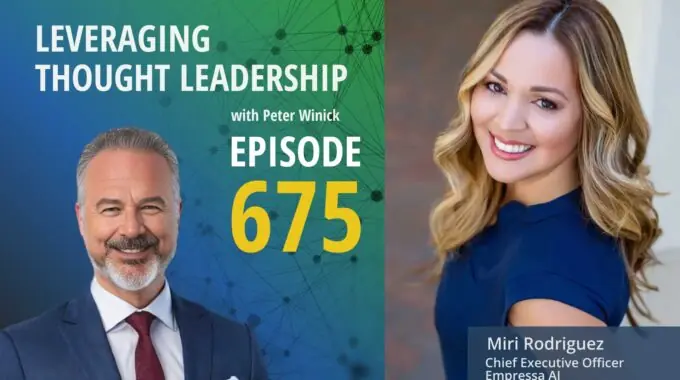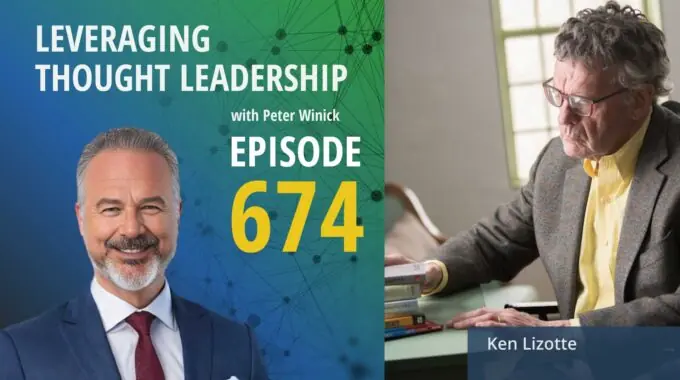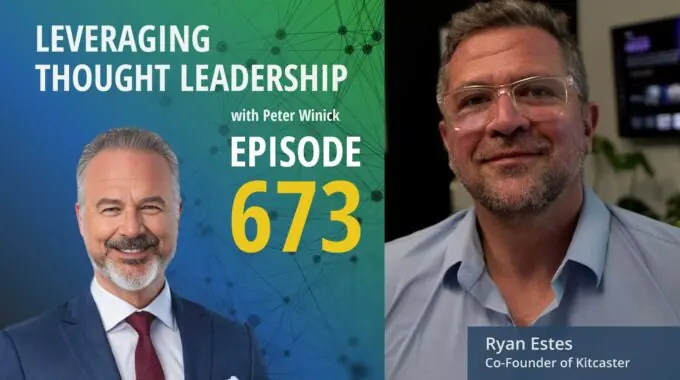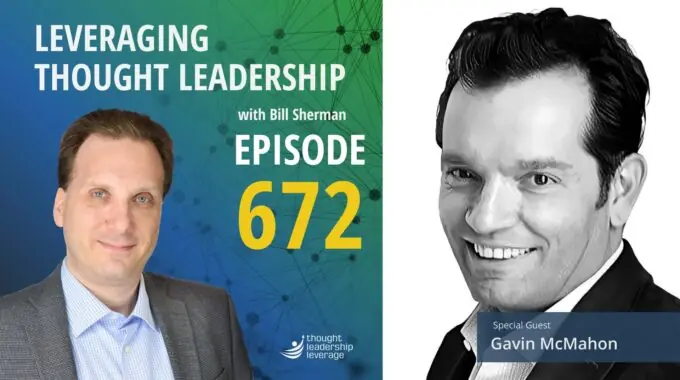Building Brand Love Through Storytelling This episode explores how storytelling can drive inclusion, purpose, and…
Leveraging Thought Leadership With Peter Winick – Episode 60 – Holly G. Green
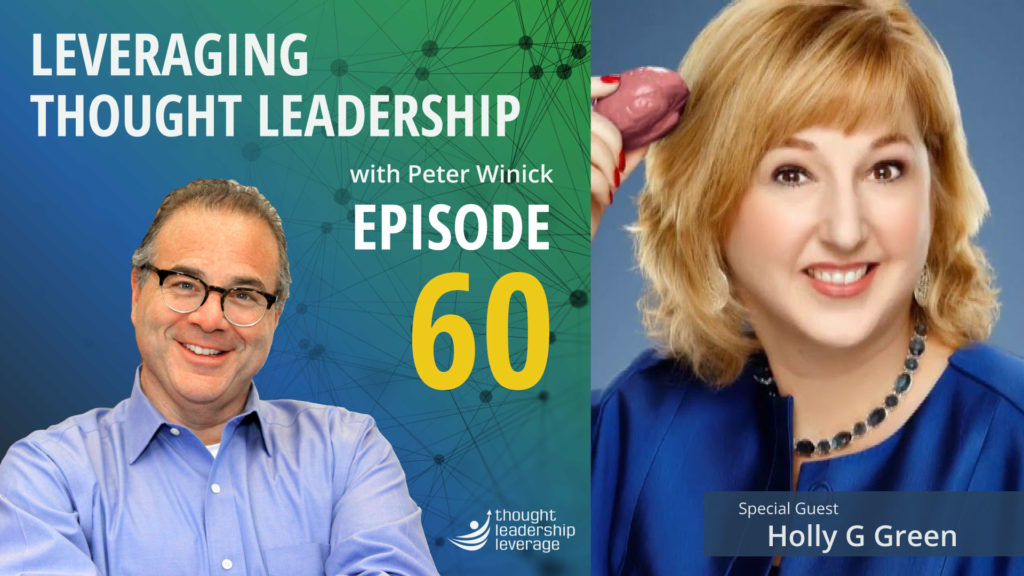
Thought Leaders must have open minds and an eagerness to learn and unlearn as times change. What once worked may no longer be the best way to succeed. Can you adapt to rapidly evolving technology and business needs?
Today our guest is Holly G. Green, CEO of The Human Factor and author of “Using Your Brain to Win.” In this episode, Holly shares her advice on keeping up with changes in the content space. She also discusses the way writing, speaking and consulting can work together to give you the best return.
Holly and Peter also get practical, talking about why charging the highest billable hour isn’t always best for you in the long term. Join us for a great episode!
If you are unsure where to put your content, let Thought Leadership Leverage handle the marketing for you!
Transcript
Peter Winick And welcome, welcome, this is Peter Winick. I’m the founder and CEO of Thought Leadership Leverage. And you’re joining us on our podcast today, which is Leveraging Thought Leadership. Today, my guest is Holly Green. Holly is the CEO and managing director of The Human Factor. She’s an author, she’s a speaker. She’s the former CEO of a couple of impressive training companies. She’s been around this content space for quite some time and she’s gonna share some of her insights and wisdom and knowledge and experience with us today, we hope. So welcome aboard, Holly. Thanks for joining us.
Holly Green Thanks so much for having me.
Peter Winick Oh, my pleasure. So why don’t we start with sort of how did you get here? So what was the path that took you to sort of thought leadership and being in the content space and doing what you do?
Holly Green Oh, my goodness. That’s quite a circuitous journey. You know, I was very lucky early on in my career. I worked for some of the world’s best companies. I worked at Dell Computer, the Coca-Cola company, AT&T, where I had access to a lot of amazing training and learning opportunities. Worked across a lot of different types of roles with a lot people globally. So I gathered up some amazing knowledge and wisdom from all of those experiences. And I found myself one day working for a Fortune 500 company and taking a nap in my office at about three o’clock every day, just so slow. And it wasn’t intellectually challenging anymore and realized the same time one of my former colleagues that I had worked with at a company reached out and said, you know what? Take some vacation, come lead our strategic planning process. come work with us, speak to our group, et cetera. And I did that and realized that’s what I was really excited about. So, you know, came back, put in a few months notice and kind of went off about, it’s been 18 years now, went off on my own and then built a small firm and began writing more and really leveraging all of these pieces and parts put together from this long journey.
Peter Winick So let’s talk about the connection of the pieces, right? So when you say you write, you speak, you consult, you advise, show me sort of how those things from a systems perspective connect and interplay with each other.
Holly Green I write about the things that I actually do. I do the things that I read about and learn about and have experienced. And I got to those places from studying others and, you know, educational background and all the roles I held. So in the writing, it forces me to get better at the speaking part of things, certainly. It forces me to focus in on key points and. to have the proper flow and make sure materials are understandable and relatable to whatever audience I’m working with. So the writing and the speaking in particular are crucial. And the consulting for me just test everything that I say. So instead of just being just an author or just a speaker, I really put everything I talk about to the test constantly with real businesses, real clients struggling with the same issues that many of us are every day. And that helps me continue to refine, so to refresh the writing and write something different and then to be able to share that more broadly and speak about that and then learn some more and continue on that loop.
Peter Winick No, I love that. And you know, the fact that you’re there with your, you know your sort of proverbial sleeves rolled up in the mix every day. There’s a big difference between a keynoter that’s out there keynoting every day, then one that’s out there, keynoting, writing, observing and actually doing the consulting, because keynoting is I don’t want to say it’s easy that it doesn’t sound right, but it’s got its own challenges. But you’re not held to the task of deliverable other than deliver the keynote in the way it was expected to be delivered and get a nice outcome in 60 minutes. Right. So Give me a sense of, let me get your, let’s put it this way, let get your reaction to this. I always tell my clients and folks that I work with that don’t label yourself, because words matter, an author or a speaker or whatever. Because if you call yourself an author, then you start to think, well, that’s what I do, right? If I called myself a plumber, that what I did. I always say to people, listen, you’re in the content business, right. So you have these ideas, you have frameworks, methodologies, et cetera. And there are lots of ways you can monetize them. And you’ve got to figure out the right mix for you of authorship, speakership, consulting, advising. Let me get your reaction to that. Tell me I’m nuts or tell me you agree, disagree. What would you add to that?
Holly Green Oh, I completely agree. You know, my sort of mantra is I’m the architect of pause, which then can be applied across any platform. And so it doesn’t narrow me into just speaking or just writing or anything else. So it’s the underlying content that really carries the flag or the banner, if you will. And it just happens to get manifested in a variety of ways.
Peter Winick Right, so talk about that in terms of the same content, living in a book that I can buy for $20 to a speech, which would be exponentially more than that. Sort of walk me through how it’s deployed and how you help people understand what the value you can extract from each of the various modalities are.
Holly Green Yeah, that’s a good question. So a lot of it is just what the market will bear. We also sell on kind of impact and the value of that. So my consulting is priced very differently than a one-time keynote. And that’s looking at that from every angle to consider a keynote is going to be a lot more expensive than one day of consulting. But none of my clients buy just one day of consulting, right? So, you know, if you’re gonna, if I’m gonna work with you ongoing and get into the nitty gritty and the true details underneath all of the things that we talk about in a keynote, the impact we’re gonna have on your business and hopefully on you as a leader is gonna be dramatically different than, you know if we just stood up and did a 45 to 60 minute kind of presentation. So.
Peter Winick Well, let me unpack that a little bit because I think sometimes people look at things at a superficial level and they don’t unpack it enough. And what I mean by that is if people look, the highest quote day rate or the highest use of an hour of your time would clearly be a keynote by far, right? And that’s true for anybody that keynotes, right, whether it’s 5,000 or 50,000, whatever. So they look at that and go, okay, well, economics says, do the things that pay you the most, right. Great. I’m going to do that. when you go into consulting, like you said, they don’t just buy one day of consulting, a consulting engagement could be worth, you know, 30 keynotes. Correct. It’s not going to take you, it’s not a direct correlation there. So you’re going from a five figure engagement to a mid six figure that’s long term, but on an hourly or daily basis, your compensation is going down. So sort of walk me through the logic of that, because I push back on people all the time saying, no, don’t Just focus on the keynote, because that’s only one market that operates in way, it’s good to have a blended portfolio of offerings and services.
Holly Green Well, I was just having this conversation, in fact, not long ago with a speaker who contacted me and said, OK, you know, a client has asked me to come in and consult and how do I do this? And, you know, and I was kind of walking through some pricing with them. And he said, well, my God, you know, that’s only a third or a fourth of what I charge for a keynote. And I said, yeah, but if you’re good, and I’m presuming that you are, you’re not no one buys one day of consulting. Right. So my clients and my consulting clients typically are on a retainer, a monthly retainer that equates to one keynote. So it’s like having 12 keynotes with one client every year. Right. There’s the real true math of that.
Peter Winick Well, the math people don’t do on keynotes is, you know, it’s more glamorous to say, oh, this is what I got for an hour’s keynote, but they don’t talk about, you know, getting lost at the airport and podunk and then the rental car. Most of them are at least two days away from home, right? When you’re doing consulting work, for the most part, obviously you have some on-site stuff, but a vast majority of that does not need to be on site with a client.
Holly Green Well, mine does, so that’s, well, I would say I’m probably about a 75, 25 split with onsite because I’m working directly with leaders in their companies, learning the business, being part of key decisions that are happening constantly, but, but I’m not popping around keynote to keynote. You know, so it’s not five cities in a week. It’s usually two cities in the week for me. So, but even the, the, I guess. For me, it’s about the longer-term relationship. It’s about stickiness of what you do. And it just sort of depends on what you want. I think, listen, if you can make a great living just doing keynotes and that’s what you, good for you, that’s fantastic. If that’s you love, good for. To me, that doesn’t have enough residual value for the client or even for me. So I learn a lot from my consulting work and I love the learning process just very selfishly. And I also provide a lot more because like I said, you do dig in, you do get into details, you’re part of the decision. You can coach and guide, sometimes push and pull along the path. You know, I want to make a lot more lasting impact.
Peter Winick Sure. That’s where I was going to go. Keynote invites very nature is transactional, right? You come in, you do the event, you go home. And the buyer of a keynote has a certain set of expectations. You’re going to be engaging, you’re going to be interesting, people walk away with a couple of ideas, but that’s it. They’re not expecting you to change the world and get people to think, do, behave, act differently. It’s just really exposure and with a little bit of entertainment. When you’re diving in as a consultant, it’s more gratifying as the provider of the services to actually see. What was the before and after? I worked with this client for 180 days and we started here and I left the world a better place. I left, you know, here’s the result of my work. Not everybody enjoys that as much, but I totally hear what you’re saying is it’s more gratifying and satisfying from an intrinsic or intellectual perspective to see that impact happen.
Holly Green Yeah, for me it is. Now some people would tell you the keynoting they love because they see the audience light up and they feel like they engage and they can, you know, maybe reach more people. I do enjoy the key noting, but I kind of go back to what you said earlier, which was for me that’s the easiest part of my business. You know, if I can fly in and do an hour and fly out.
Peter Winick Not a lot of prep and right, right. You’re not doing deliverables and decks and crunching numbers on some. So let me ask you this. You went out on your own 18 years ago. So 2000, right?
Holly Green About then, I guess. Actually, probably it was, yeah, yeah. Close enough.
Peter Winick Plus or minus, whatever. So again, you know, to those of you under a certain age, this was the age before, you probably had an email address. You definitely didn’t have Twitter. You definitely don’t have social media. That’s right. Lots of things were different. You didn’t communicate as much via social. Give me a sense of the things that have changed and how you’ve changed with it to stay on top of your game. Oh my gosh. So when, you 18 years ago, back of the room was a big deal. Like give us a little bit of the, what’s different, what’s changed and how have you evolved with the times to stay top of game.
Holly Green Yeah, yeah, it’s so funny. I haven’t even seen or done a back of the room now, you know, in 10 years. Well, you know, I was one of the first million people on Twitter. They send me something every year reminding me of that, which I always think is pretty funny because it wasn’t that I was on the bleeding edge of technology. It just happened to correlate 2008 was the year my first book was published. And so of course, we had to get it out on Twitter, you know, that was the latest, greatest platform. So. Today, for me, it’s about sharing content and engaging with clients and prospects and just interested parties through all those channels very differently. So, I’ve got a database of 20,000 people we can reach with a newsletter, we can tweet, I can do a Facebook post, we can go out to our LinkedIn groups. And so in some ways it’s easier but it’s just so many more channels or platforms today that you have to manage.
Peter Winick So let’s talk about that because it’s easier and harder, right? So back in the good old days of 20 years ago, and I’m being sort of somewhat snarky, it was if I had your contact information, it was Dear Holly, your current resident, and the LLB catalog got to you or whoever bought your house, right, but now we may be communicating on LinkedIn, and that has one sort of set of rules, not hard rules, but customs, if you will, maybe Twitter, maybe by email, maybe my, you know, I might be touching you seven or eight different ways. And the platform dictates sort of the protocol and the modality. And, you know, it’s different to communicate via Twitter, via tweet than it is in a newsletter that you might produce and send out to your database. So how do you, how do decide what the right mix is for you? And I’m assuming it’s obviously to yield some marketing benefit to the firm.
Holly Green Sure. Well, yeah, and some of it is real and some of it’s just to create the mental model that we want to achieve. So what I mean by that is we have everything pretty well linked up. So I can do one or two things a day and it looks like I’m on 40 different channels, right? And part of that is, we want it to look like I am everywhere. And you want to kind of saturate in some ways. And then you want to just refine by channel so that there are some things you only do specific to that channel. You know, there’s some things I only do on LinkedIn because it’s a little more targeted to the group that I’m in on LinkedIn or to the people I’m trying to reach on LinkedIn. I find it’s very different audiences. You know Facebook tends to be more friends and friendly colleagues, if you will. You know LinkedIn to me, I use it as a much more business tool, really hardcore business. You know Twitter is just masses, who the hell knows what it is really.
Peter Winick But don’t put a picture of yourself on LinkedIn with a margarita.
Holly Green Exactly. Exactly. Well, although I might on Facebook.
Peter Winick Yeah, right, right.
Holly Green Yeah, somebody.
Peter Winick Every Friday around four is when we come to do that.
Holly Green Understanding the basics of the channels like you said the mores and norms of those channels and how do you leverage that and it’s it’s also Applying content as widely as you can when that will work across all the channels So we do both it’s and we’re constantly evolving it and learning. Okay, what worked last year? Well things moved is shifted a little bit this year I mean I can tell you we don’t really focus as much energy on Twitter as we used to you know That’s just we focus a little more on LinkedIn
Peter Winick But the trick is that you’re constantly experimenting and you’re monitoring if Twitter, all of a sudden, there was some new something that you did a hashtag, it was different or whatever, and that yielded some more results, then you’d allocate more resources there, right? Because if it yields fruit, then why bother? And how do you go about sort of because you have to be careful with your time. So I love what you said in terms of you can take the same piece and sort of broadcast it across multiple channels, because that’s highly efficient. What are the criteria that you use to say, okay, this is working, this isn’t working, because I think sometimes people get too focused on metrics that are actually not metrics that are meaningful, like retweets or likes or like, I don’t know how to cash a like in the bank. Well, exactly, or retweet. I look at our marketing spending and go, did it find his clients or not?
Holly Green Well, and that’s the hard thing because I can tell you, I don’t know that I’ve ever gotten a client directly from any of that activity, but when I speak to potential clients, all of them, you know, not all of the, many of them will say, oh yeah, I saw this come across on LinkedIn or I saw there. So it really is kind of anecdotal evidence mostly.
Peter Winick Interesting. Okay, so you’re not you’re not getting direct because it’s you know, we have clients and they’re ourselves included where we can directly connect, you know, okay, so this happened via LinkedIn, and then that came or whatever. And then there is to you know to your point, there’s the call it, you know credibility builder, or you know, given that decisions are rarely made by one person when you know you have an interaction with someone and they say who is this holly person, they can go check you out and go Ah, okay. She’s the real deal, right? So there’s a little bit of the credibility enhancer.
Holly Green Yeah, and I would say for us the platforms are more marketing than sales. So all marketing you hope drives sales eventually, but the correlation, the direct correlation, is often very hard to put your thumb on. The vast majority of my business is people that have specifically seen me, spoken to me, or I worked with or worked for previously. It’s almost all referral or direct interaction. And so, you know, and we’re a little different in that way. I think when the things that I do, because in different and not so different, I mean, many, many consultants, you buy the person, you don’t buy the brand, if you will, and I’ve tried to be very conscious on building both person and brand, but you’re, you’re kind of buying me and my approach specifically in the things I can bring. So. That’s why I say it’s a little more of a, those are a little marketing tools versus direct sales tools.
Peter Winick No, and it’s good to differentiate that, because if you were doing targeted campaigns, those are more marketing tools with a sales expectation, right? Putting out solid content, it’s rare that somebody’s gonna call you directly, there was a total stranger and say, I read the article and I wanna go now, I hire you and here’s a six month contract, right. Yeah.
Holly Green Yeah, and we do with everyone we come across. That’s how we built our database to 20,000 interested people, if you will. Everyone in there is a double opt-in. Those people we have campaigns to that are very specifically content oriented that drive to a specific product or process. So we tend to use the outreach of the campaigns more than the social channels to try to drive the business directly.
Peter Winick So any last thoughts or recommendations? So what do you say now to someone who in 18 years from now will be where you are today?
Holly Green I’ll say, I’m so sorry. You have my deepest sympathy and empathy. I think it’s being willing, and we talk a lot about this in the business too, is being willing to continue to learn and unlearn. Because if you had asked me 10 years ago, I would have said some very different things about the channels. We were trying to use the Moore’s Direct Sales. We thought that could work, et cetera. And just we’ve learned and played around and tried different things over the years. So it’s a constant unlearning, learning, unlearning learning process. and you have to be willing to keep going through that. And I do think a lot of people who are successful initially forget that you have to keep shaking it up and refreshing, and then things get very stale very quick.
Peter Winick No, I love that. And sometimes quite frankly, as we get older, I can speak for myself, the unlearning is harder than the learning, right? To have to accept a new process theory, way of thinking that contradicts something that you believed or did work in a certain way for you for a period of time, that’s not so easy.
Holly Green Absolutely not. It’s one of the hardest things that the adult human does when you’re coming from success in particular.
Peter Winick Exactly, exactly. Well, I appreciate all that you’ve shared. There’s been a lot of really solid information based on your experience, which has been great. And I thank you again for your time and thank you for being here with us today.
Holly Green You are most welcome. Thank you so much for having me.
Peter Winick To learn more about thought leadership leverage, please visit our website at thoughtleadershipleverage.com. To reach me directly, feel free to email me at peter at thoughtleadershipleverage dot com. And please subscribe to Leveraging Thought Leadership on iTunes or your favorite podcast app to get your weekly episode automatically.


